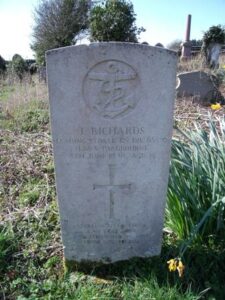Cosheston is a peaceful village and parish in Pembrokeshire, West Wales, situated in a beautiful position on an inlet of the Daugleddau estuary, two miles north-east of Pembroke. The northern part of the parish is in the Pembrokeshire Coast National Park. Together with the parishes of Upton and Nash, it constitutes the community of Cosheston. With the community of Lamphey, it makes up the Pembrokeshire ward of Lamphey. The Cosheston war memorial takes the form of a granite plinth and is located outside an old building, the Funeral Car Tenement, which lies in the village.
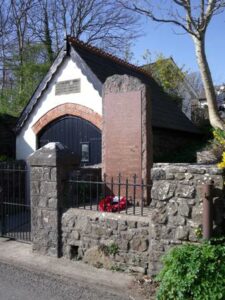
The Great War, 1914-1918
Frances Ethel Brace, Staff Nurse, Queen Alexandras Imperial Military Nursing Service. Frances was born early in 1886, the daughter of William and Jane Brace of Beaver’s Hill, Manorbier. By 1901, Jane had passed away, and the family lived at Great Honeyborough Farm, at Neyland, where Frances worked for her father. She then trained as a nurse, obtaining a post at Carmarthen Infirmary at sometime in 1912. After four years at Carmarthen, Frances then volunteered for service with Queen Alexandra’s Imperial Military Nursing Service on 16 June 1916, and was posted to a Field Ambulance in Salonika. The British had opened up a front in Salonika late in 1915 to aid the Serbian Army against an attack by Austro-Hungarian troops. The campaign became better known for the disease and suffering in the taxing conditions the troops faced there. Frances was one of many to succumb to illness at Salonika. She contracted malaria, and was evacuated to the Military Hospital at Malta, where she died on 21 September, 1916, just three months into her military service. She was by then 30 years old, and is buried at Pieta Military Cemetery, Malta. Her Memorial Plaque, together with its Buckingham Palace accompanying slip and envelope, two contemporary photographs of Frances at a field hospital, another of her grave, and another of the Cosheston Memorial, together with related newspaper cuttings and a silk memorial cloth, printed with her photograph and an epitaph, were sold at Sotheby’s in 2000 for £770. She is also commemorated at the West Wales General Hospital, Carmarthen.

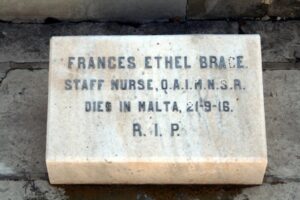
Samuel Bradfield Cozens, Private, 145969, Machine Gun Corps. Samuel was born at Pembroke on 1 May 1899, the son of Thomas Charles Cozens and Eveline Cozens (nee White). The family later resided at the Post Office, Cosheston, Pembroke. Samuel was called up into the army late in 1917, and after training was posted to the 17th Battalion, Machine Gun Corps, attached to the 17th (Northern) Division. In March, 1918 the Division were on the Somme, and faced the German Spring Offensive there, fighting at the Battle of St Quentin, and retreated back, fighting at the First Battle of Bapaume. After a period out of the line to rest and rebuild, the Division moved to the southernmost sector of the Somme area, where they fought at the Battle of Amiens on 8 August 1918, a day which saw the war swing in the favour of the Allies. The Allies then advanced on the Somme, and the Division fought at the Battle of Albert later that month, which marked the beginning of the advance to victory. Samuel was killed during the first week of the great advance, on 28 August 1918. He was 20 years old, and is commemorated on the Vis-En-Artois Memorial, France. His brother, Hubert White Cozens, was awarded the Military Medal during the war. The photograph of Samuel is courtesy of Joy Cozens, his niece.
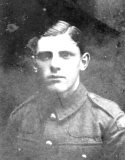
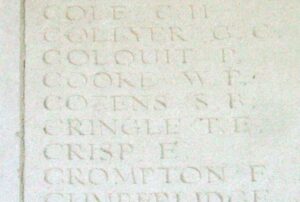
Frank Godsell, Private, 11995, Royal Welsh Fusiliers. Frank was the son of John and Rosetta Fanny Godsell, of 29, Brunswick Street, Cheltenham. He had worked at Upton Farm, Cosheston as a farm hand for several years prior to the war, and enlisted at Tumble into the 9th Battalion, Royal Welsh Fusiliers, which was attached to 58 Brigade, 19th (Western) Division. The Division moved to France during July 1915, and moved to positions near Loos, where it took part in the opening attack of the Battle of Loos on 25 September 1915. The following year the Division moved to the Somme, where it took part in the second wave of the attack on Ovillers-La Boiselle on 1 July, capturing the village at heavy cost. Frank was killed in action here on 3 July 1916, aged 26. He is buried at Serre Road Cemetery No. 2, France. Frank is not commemorated locally.
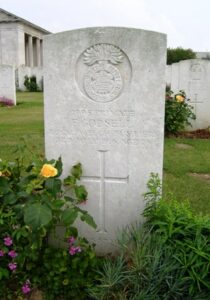
William Edgar Noot, Private, 54460, Welsh Regiment. William was the son of William and Mary Noot, of Hall Farm, Cosheston, Pembroke. He had volunteered for service with the Welsh Regiment, and after training was posted as a reinforcement to the 19th Battalion, Welsh Regiment, the Pioneer Battalion of the 38th (Welsh) Division. The Division had been in France since December 1915, and had fought in epic battles at Mametz Wood and the Pilckem Ridge. In the spring of 1918 they were moved from Flanders to bolster the British lines on the Somme, and took up positions around Aveluy Wood, where they remained until the launch of the great advance on 24 August 1918. Over the coming weeks the Division pushed its way through the Germans, driving through the Canal du Nord and the Hindenburg Line towards the mighty Forest Of Mormal. William was wounded at Mormal, and evacuated to the Military Hospital at Abbeville for treatment, but died of wounds there on 10 November, 1918. He was 32 years old, and is buried at Abbeville Communal Cemetery Extension, France.
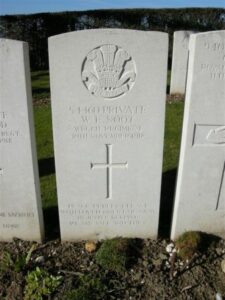
William George Phillips, Private, 54385, Welsh Regiment. William was born in 1891, the third child of Thomas and Elizabeth Phillips, of Mayeston, Cosheston. He worked as a gardener until joining the Welsh Regiment, and was posted to the 16th Battalion, Welsh Regiment. The battalion was the Cardiff City battalion, and had been in France since December 1915 attached to 115 Brigade, 38th (Welsh) Division. Judging by his service number, William joined the battalion after its part in the successful capture of Mametz Wood, and its move to positions at Boesinghe, north of Ypres. The Division was destined to hold the line here until August 1917, when it made its assault on Pilckem Ridge. On 23 May 1917, A Company, 16th Welsh were in the line near Village Street, when they were shelled by German heavy guns. Eight men were killed and a further eight wounded. William was one of the dead. He was 25 years old, and is buried at Ferme-Olivier Cemetery, Belgium.
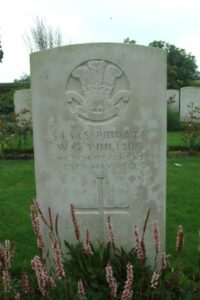
Frederick John Purser, Corporal, 27535, Royal Field Artillery. Frederick was the son of William and Sarah Purser, of Mayeston Lodge, Cosheston, Pembroke. He was called up for service in the Army, and joined the Royal Field Artillery, where after receiving his training, Frederick was posted to their “B” Battery, 175th Brigade. By the summer of 1917 the unit was at Ypres, and was used for firing preparatory barrages onto the German lines, during the build up to the Passchendaele Offensive. Frederick was killed by a German shell whilst working on telephone wires connecting his battery to a signalling station on 24 July, 1917 aged 27. He is buried at Coxyde Military Cemetery, Belgium.
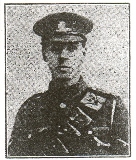
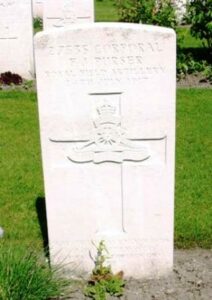
John Thomas, Petty Officer 1st Class, 136222, Royal Navy. John was born at Cosheston on 28 September 1869, the son of John Thomas. He had served with the Royal Navy for many years prior to the war, after originally enlisting on 28 September 1887. In 1905 he retired and transferred to the Royal Naval Reserve, but re-enlisted into the Royal Navy at the outbreak of war, serving at HMS Vivid I before being posted to HMS Defiance, the Royal Navy torpedo school. John took ill and died of pneumonia on 19 January 1916. He was 47 years old and is buried in Newport (St. Woolos) Cemetery, Gwent. He does not appear to be commemorated locally.
William Hayes Thomas, Leading Stoker, 307910, Royal Navy. William was born at 18, Park Road, Chatham on 24 June 1884, the son of Charles and Annie Thomas. The family was originally from Dale, Pembrokeshire, but prior to the Great War had moved to Slade, Cosheston. William served with the Royal Navy as a Stoker aboard H.M. Submarine E13. Just after 2300 on 17 August 1915 a faulty compass forced HMS E13 aground on a mud bank in Danish Territorial waters. The helpless E13 then came under fire from two German destroyers on 19 August 1915. Fifteen crew members were killed but a Danish torpedo boat, Soloven, prevented E13’s destruction. The Danes then interned the remaining crew and boat on 3 September 1915. William was one of the dead, killed on 19 August 1915, aged 31. His body was sent back to Wales, where he was buried at Cosheston (St. Michael) Churchyard. William was the holder of the Cross of St. George 4th Class (Russia).
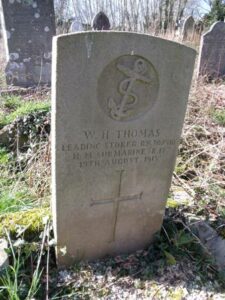
Thomas George Warlow, Private, 9948, Welsh Regiment. Thomas was the son of Isaac and Elizabeth Warlow (Step-mother), of Ringlewells, Cosheston. He was a regular soldier in the Army, serving at the outbreak of war with the 1st Battalion, Welsh Regiment, which was in India. The regular army battalions scattered around the British Empire were recalled to England after the outbreak of war, with the 1st Welsh returning to join 84 Brigade, 28th Division. The Division formed in England between December 1914 and January 1915 from regular units returning from India, Singapore and Egypt. During January 1915 it moved to France, landing at Le Havre and moved to the Western Front, where it saw its first major action during the Second Battle of Ypres. Thomas was killed at Ypres on 17 February 1915. He was 24 years old, and is commemorated on the Ypres (Menin Gate) Memorial, Belgium.
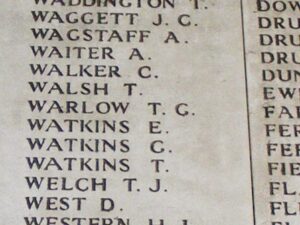
The Second World War, 1939-1945
Douglas Aubrey Godfrey, Warrant Officer Class II (C.S.M.), 6285717, South Staffordshire Regiment. Douglas was the son of Charles and Dorothy Godfrey, of East Grinstead. He married Violet Mary Williams, of Cosheston, while based in Pembrokeshire in 1940. Douglas served with the South Staffordshire Regiment, and had trained as a paratrooper, being attached to the 2nd Airborne Battalion, South Staffordshire Regiment. The battalion had formed in 1941, and took part in the Bruneval Raid, and operations in North Africa, Sicily and Italy before returning to Britain. It then took part in Operation Market Garden, landing at Arnhem on 17 September 1944. As is well known today, the daring operation failed, and the remnants of the airborne troops were evacuated from Arnhem a week later, with over 6,500 men lost. Douglas was shot in the stomach during the evacuation from Oosterbeek, and died at Apeldoorn on 28 September 1944, aged 27. He is buried at Arnhem Oosterbeek War Cemetery, Netherlands. His widow Violet married Anthony Asparassa in 1954, and died in 1989. Douglas does not seem to be commemorated locally.
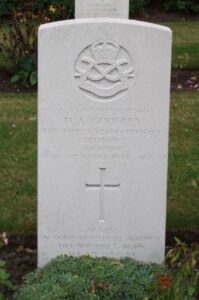
Henry George Gullam, Serjeant, 4031651, The Durham Light Infantry. Henry was the son of Arthur and Elizabeth Gullam, of Cosheston, Pembrokeshire. He originally enlisted into the King’s Shropshire Light Infantry, but was later transferred, and served with the 16th Battalion, Durham Light Infantry, which was formed in Edinburgh in early July 1940. The Battalion consisted of mainly civilian conscripts, with most of its NCOs drawn from the Bedfordshire and Hertfordshire Regiment. After much training the Battalion sailed on Christmas Day 1942 from Liverpool aboard the MV Staffordshire, as part of 139 Brigade, 46th Infantry Division of the First Army. Entering war for the first time in the Green Hill sector of Northern Tunisia on 17 January 1943, the 16th DLI suffered grievous losses in the Battle of Sedjenane, which began on the morning of 27 February 1943. The 16th played a major role in the Salerno Landings of September 1943 and the subsequent gruelling campaign in Italy. In December 1944, 16 DLI was flown to Greece, and it was here that Henry was taken ill. He died in hospital on 14 January 1945, aged 31, and is buried at Fayid War Cemetery, Egypt.
Leslie Thomas John Harries, Petty Officer, D/JX 133513, Royal Navy. Leslie was the son of James B. and Martha J. Harries, of Cosheston. Leslie served with the Royal Navy aboard HMS Dorsetshire, a County class heavy cruiser. She had been sent to take part in the hunt for the Graf Spee, and remained in the South Atlantic for several months. She returned to Britain before being despatched via South Africa to the Indian Ocean, returning to the North Atlantic to take part in the hunt for the Bismarck. Dorsetshire was the ship that finally sunk Bismarck, by torpedoing the stricken ship. In 1942 Dorsetshire returned to the Indian Ocean, and on 5 April 1942 was attacked and sunk by Japanese dive bombers. Leslie was one of over 230 men killed in the sinking. He was 28 years old, and is commemorated on the Plymouth Naval Memorial, Devon. Leslie does not seem to be commemorated locally.
Thomas Richards, Leading Stoker, D/K 65339, Royal Navy. Thomas was the son of Mr. and Mrs. J. Richards of Cosheston, and the husband of Martha Jane Richards, of Llanreath, Pembroke. He was a regular in the Royal Navy, and served aboard H.M.S. Pangbourne, an Aberdare Class Minesweeper. Pangbourne took part in Operation Dynamo, the evacuation of troops from Dunkirk, and was heavily involved on 10 May 1940. Thomas was most probably wounded during the evacuations, as the Royal Naval fleet was being heavily attacked by German Stuka dive bombers during the course of getting the men of the BEF safely off the beaches. He died on 4 June 1940 aged 35, and is buried at Cosheston (St. Michael) Churchyard.
